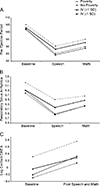Dimensions of Adversity, Physiological Reactivity, and Externalizing Psychopathology in Adolescence: Deprivation and Threat
- PMID: 27428857
- PMCID: PMC5237627
- DOI: 10.1097/PSY.0000000000000369
Dimensions of Adversity, Physiological Reactivity, and Externalizing Psychopathology in Adolescence: Deprivation and Threat
Abstract
Objective: Dysregulation of autonomic nervous system and hypothalamic-pituitary-adrenal (HPA) axis function is a putative intermediate phenotype linking childhood adversity (CA) with later psychopathology. However, associations of CAs with autonomic nervous system and HPA-axis function vary widely across studies. Here, we test a novel conceptual model discriminating between distinct forms of CA (deprivation and threat) and examine their independent associations with physiological reactivity and psychopathology.
Methods: Adolescents (N = 169; mean [SD] age, 14.9 [1.4] years) with a range of interpersonal violence (e.g., maltreatment, community violence) and poverty exposure participated in the Trier Social Stress test (TSST). During the TSST, electrocardiogram, impedance cardiograph, salivary cortisol, and dehydroepiandrosterone-sulfate data were collected. We compared the associations of poverty (an indicator of deprivation) and interpersonal violence (an indicator of threat) on sympathetic, parasympathetic, and HPA-axis reactivity to the TSST, and assessed whether these differences mediated the association of adversity with internalizing and externalizing symptoms.
Results: Exposure to poverty and interpersonal violence was associated with psychopathology. Interpersonal violence, adjusting for poverty, was associated with blunted sympathetic (b = 1.44, p = .050) and HPA-axis reactivity (b = -.09; p = .021). Blunted cortisol reactivity mediated the association of interpersonal violence with externalizing, but not internalizing, psychopathology. In contrast, poverty was not associated with physiological reactivity after adjusting for interpersonal violence.
Conclusions: We provide evidence for distinct neurobiological mechanisms through which adversity related to poverty and interpersonal violence is associated with psychopathology in adolescence. Distinguishing distinct pathways through which adversity influences mental health has implications for preventive interventions targeting youths exposed to childhood adversity.
Conflict of interest statement
The authors have no financial disclosures or conflicts of interest to report.
Figures


Similar articles
-
Effects of early adversity on young children's diurnal cortisol rhythms and externalizing behavior.Dev Psychobiol. 2015 Dec;57(8):935-47. doi: 10.1002/dev.21324. Epub 2015 Aug 19. Dev Psychobiol. 2015. PMID: 26289841 Free PMC article.
-
Physiological Stress Response Reactivity Mediates the Link Between Emotional Abuse and Youth Internalizing Problems.Child Psychiatry Hum Dev. 2021 Jun;52(3):450-463. doi: 10.1007/s10578-020-01033-1. Child Psychiatry Hum Dev. 2021. PMID: 32720015 Free PMC article.
-
Dysregulation of the sympathetic nervous system, hypothalamic-pituitary-adrenal axis and executive function in individuals at risk for suicide.J Psychiatry Neurosci. 2010 Nov;35(6):399-408. doi: 10.1503/jpn.090121. J Psychiatry Neurosci. 2010. PMID: 20731961 Free PMC article.
-
Co-activation of SAM and HPA responses to acute stress: A review of the literature and test of differential associations with preadolescents' internalizing and externalizing.Dev Psychobiol. 2019 Nov;61(7):1079-1093. doi: 10.1002/dev.21866. Epub 2019 May 18. Dev Psychobiol. 2019. PMID: 31102264 Free PMC article. Review.
-
Annual Research Review: Early adversity, the hypothalamic-pituitary-adrenocortical axis, and child psychopathology.J Child Psychol Psychiatry. 2018 Apr;59(4):327-346. doi: 10.1111/jcpp.12784. Epub 2017 Jul 17. J Child Psychol Psychiatry. 2018. PMID: 28714126 Free PMC article. Review.
Cited by
-
Differential associations of parental harshness and parental disengagement with overall cortisol output at 15 years: Implications for adolescent mental health.Dev Psychopathol. 2022 Feb;34(1):129-146. doi: 10.1017/S0954579420000954. Epub 2020 Oct 19. Dev Psychopathol. 2022. PMID: 33070808 Free PMC article.
-
Role of Human-Computer Interaction Healthcare System in the Teaching of Physiology and Medicine.Comput Intell Neurosci. 2022 Apr 13;2022:5849736. doi: 10.1155/2022/5849736. eCollection 2022. Comput Intell Neurosci. 2022. Retraction in: Comput Intell Neurosci. 2023 Nov 1;2023:9812579. doi: 10.1155/2023/9812579. PMID: 35463243 Free PMC article. Retracted.
-
Maltreatment subtypes, depressed mood, and anhedonia: A longitudinal study with adolescents.Psychol Trauma. 2019 Oct;11(7):704-712. doi: 10.1037/tra0000418. Epub 2018 Dec 27. Psychol Trauma. 2019. PMID: 30589315 Free PMC article.
-
Family stress during the pandemic worsens the effect of adverse parenting on adolescent sleep quality.Child Abuse Negl. 2022 Jan;123:105390. doi: 10.1016/j.chiabu.2021.105390. Epub 2021 Nov 15. Child Abuse Negl. 2022. PMID: 34794017 Free PMC article.
-
The Interaction of Polygenic Susceptibility to Stress and Childhood Adversity Dimensions Predicts Longitudinal Trajectories of Stress-Sensitivity.Stress Health. 2024 Dec;40(6):e3499. doi: 10.1002/smi.3499. Epub 2024 Nov 14. Stress Health. 2024. PMID: 39540673 Free PMC article.
References
-
- Shonkoff JP, Garner AS, Siegel BS, Dobbins MI, Earls MF, Garner AS, McGuinn L, Pascoe J, Wood DL. The Lifelong Effects of Early Childhood Adversity and Toxic Stress. Pediatrics. 2012 Jan 1;129(1):e232–e246. - PubMed
-
- Kessler RC, Avenevoli S, Ries Merikangas K. Mood disorders in children and adolescents: an epidemiologic perspective. Biol Psychiatry. 2001;49(12):1002–1014. - PubMed
-
- Teicher MH, Andersen SL, Polcari A, Anderson CM, Navalta CP, Kim DM. The neurobiological consequences of early stress and childhood maltreatment. Neurosci Biobehav Rev. 2003 Mar;27(1–2):33–44. - PubMed
Publication types
MeSH terms
Grants and funding
LinkOut - more resources
Full Text Sources
Other Literature Sources
Medical

